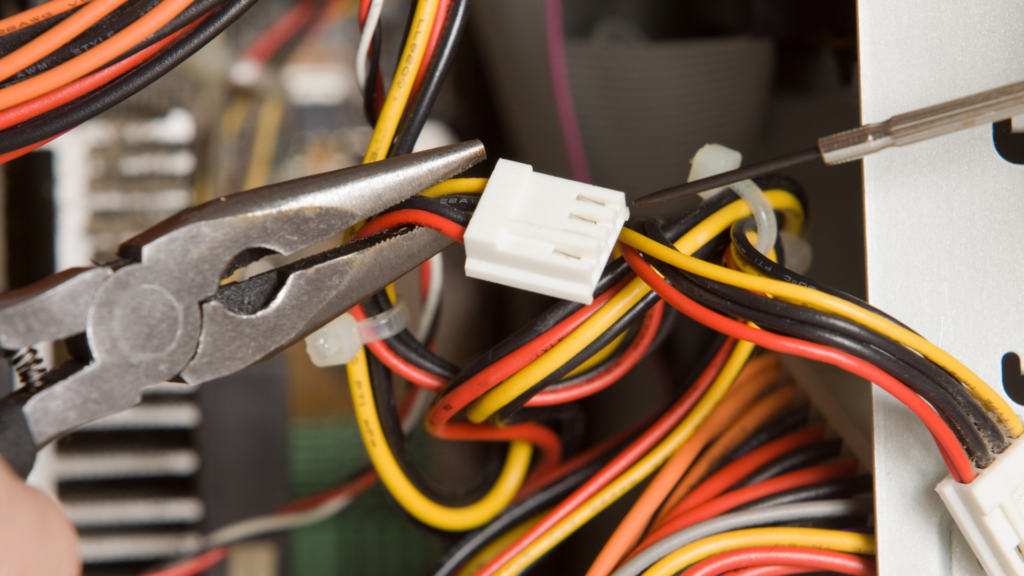As a business owner, you know the importance of having a safe and reliable electrical system. Commercial electrical wiring is vastly different from residential wiring and requires specialized knowledge to ensure that the system is correctly installed and functioning correctly. In this blog, we will explore the different types of commercial electrical wiring in-depth so that you can make informed decisions about your business’s electrical needs.
We will go over the importance of proper electrical wiring in commercial spaces and safety concerns with improper wiring. We will also dive into the various types of commercial electrical wiring, including raceways & conductors, busways, and cable assemblies. By the end of this blog, you will have a thorough understanding of each type of commercial electrical wiring and be able to determine which one is best suited for your specific needs.
Understanding Commercial Electrical Wiring
Commercial electrical wiring is essential for the smooth operation of commercial spaces. It ensures safety, efficiency, and reliability. Understanding this wiring is crucial for business owners and electricians. Compliance with safety regulations is necessary for these projects, involving various wiring methods and components like electrical panels, smoke detectors, power receptacles, and solar panels. Commercial electrical work often follows the National Electrical Code (NEC) Article and its requirements. The most common types of wiring include NM, MC, UF, and MI, each with unique features and applications.
Importance of Proper Electrical Wiring in Commercial Spaces
Proper electrical wiring in commercial spaces is crucial for minimizing the risk of electrical hazards. It promotes uninterrupted power supply and ensures efficient distribution of electrical power to different equipment. Reliability in electrical wiring reduces the chances of equipment damage and electrical fires. Following safety standards in commercial electrical wiring enhances the overall safety of commercial properties. By prioritizing proper electrical wiring, businesses can create a safe and functional environment for their employees and customers.
Safety Concerns with Improper Wiring
Improper electrical wiring poses safety concerns in commercial spaces. It increases the risk of electrical shocks and fires, threatening the safety of occupants. Inadequate wiring can also lead to equipment damage, interruptions, and business downtime. To avoid these risks, regular maintenance of commercial electrical systems is crucial to identify any wiring safety concerns. By adhering to proper electrical installation practices and following national electrical codes, businesses can ensure the safety and reliability of their electrical systems.

Deep Dive into the Types of Commercial Electrical Wiring
Understanding different types of electrical wiring methods is crucial for electricians in commercial applications. Factors like building type and electrical needs influence the choice of wiring. Electricians must be knowledgeable about common conductors like Types SE, NM, MC, UF, and MI, as well as NEC requirements. Commercial installations may include electrical panels, smoke detectors, power receptacles, and solar panels. Each type of wiring has unique characteristics that determine its suitability for specific applications in commercial spaces.
Overview of Different Wiring Types
NM cable is commonly used in residential wiring and some commercial applications. RMC provides maximum protection in commercial construction. Bus ducts are frequently used in commercial projects. UF cable is commonly used for outdoor direct burial feeders in commercial wiring. MI cable is ideal for emergency systems in commercial spaces due to its excellent fire resistance.
Exploring Raceways & Conductors
Raceways and conductors are integral components of commercial electrical wiring systems. Electricians rely on their understanding to design and install efficient electrical distribution systems. Different types of conductors, such as copper and aluminum, are utilized based on specific applications in commercial wiring. Raceways, such as conduit and cable trays, provide essential cable organization and protection in these electrical systems. The proper installation of raceways and conductors is crucial to ensure electrical safety, code compliance, and the durability of the entire system.
Defining Raceways & Conductors
Raceways, like metal conduit, nonmetallic conduit, and cable trays, are commonly utilized in commercial electrical installations. They serve as protective enclosures that house electrical cables, conductors, and wiring methods. Conductors, such as copper, aluminum, or other conductive materials, enable the flow of electric current in commercial wiring systems. These include power cables, bus bars, and electrical wires, which carry electrical power. Working together, raceways and conductors provide electrical distribution, protection, and organization within commercial electrical systems.
Common Uses and Applications
Low voltage wiring finds application in telecommunications and security systems. Flexible conduit wiring is ideal for machines and equipment due to its easy installation and maintenance. Power cable wiring is commonly used for electrical power distribution in commercial buildings. Armored cable wiring provides physical protection and is often utilized in industrial settings. Non-metallic sheathed wiring is suitable for lighting and power outlets in residential and small commercial buildings. These are the most common types of wiring used in various applications and industries.
Pros and Cons of Raceways & Conductors
Metal conduit, like rigid metal conduit, provides maximum protection but requires labor-intensive installation. Nonmetallic conduit, such as PVC conduit, offers flexibility, ease of installation, and corrosion resistance. Cable trays provide cable organization and adaptability but require regular maintenance. Bus ducts, like busways, allow for efficient power distribution and future scalability but have specific electrical requirements. Different conductors have various applications, advantages, and limitations based on electrical needs and safety regulations.

Understanding Busways in Commercial Wiring
Busways, a type of bus duct commonly found in commercial electrical distribution systems, offer a flexible, cost-effective, and efficient solution for power distribution. By understanding busways, electricians can effectively design, install, and maintain commercial electrical systems. Different types of busways, such as cable bus, feeder bus, and plug bus, have specific applications and installation requirements. Proper installation of busways is crucial to ensure electrical safety, system reliability, and compliance with electrical codes and standards.
What Are Busways?
Busways are a type of electrical distribution system that consists of metal enclosures, conductors, and busbars. They offer a flexible and cost-effective solution for commercial electrical wiring needs. With quick and easy installation, busways provide high electrical safety standards and enable efficient power distribution throughout commercial buildings.
Advantages of Using Busways
Busways have several advantages in commercial electrical installations. They provide flexibility, allowing for easy modifications and expansions. This makes them adaptable to changing requirements. Additionally, busways reduce cable clutter, improve maintenance efficiency, and have a higher electrical load capacity compared to traditional wiring methods. They are suitable for projects of varying sizes and their installation is less disruptive as it eliminates the need for extensive wiring work. Lastly, busways are durable and can withstand physical damage, ensuring the safety and longevity of electrical systems.
Potential Drawbacks of Busways
While busways offer numerous advantages in commercial electrical installations, there are also potential drawbacks to consider. Busways may require specific clearance space, maintenance access, and adherence to safety regulations. Initially, the cost of busways can be higher compared to traditional wiring methods. Modifying busways can be challenging and may require professional electricians with expertise in busway systems. Additionally, busways may limit the flexibility of electrical system design, particularly in complex commercial properties. They may not be suitable for outdoor direct burial feeders, underground applications, or specific electrical needs.
An Insight into Cable Assemblies
Cable assemblies are an integral part of commercial electrical wiring systems, serving the purpose of connecting electrical components and power sources. They consist of conductors, insulation, and an outer sheath, providing both protection and organization to the electrical cables. These assemblies come in various types, including nonmetallic sheath, metallic sheath, and nylon jacket, each designed for specific applications. They are widely used in new construction, renovations, and electrical distribution projects. Regular maintenance of cable assemblies is crucial to ensure electrical safety and optimal system performance.
The Role of Cable Assemblies in Electrical Wiring
Cable assemblies play a vital role in commercial electrical systems, serving as the conduit for delivering electrical power to equipment, outlets, and appliances. These assemblies provide the necessary electrical connections between various components, ensuring the smooth flow of electricity. In addition to facilitating power distribution, cable assemblies offer protection against physical damage and electrical hazards, while also addressing cable organization challenges. Designed to meet safety standards and regulations, they minimize the risk of electrical failures. Furthermore, cable assemblies are versatile, accommodating different wiring methods, cable types, and installation requirements.
The Benefits of Using Cable Assemblies
Cable assemblies are a preferred choice for commercial electrical installations due to their numerous benefits. They simplify the installation process, save time, and reduce errors. Additionally, cable assemblies provide maximum protection against damage, power loss, and safety hazards. They come in standard products with different lengths, cable types, and connectors for convenient installation. With reliable electrical connections, cable assemblies ensure consistent power distribution, proper equipment operation, and compliance with safety regulations. They are also compatible with various commercial electrical systems, applications, and specific wiring needs.
Disadvantages of Cable Assemblies
While cable assemblies offer advantages in commercial electrical installations, it’s important to consider their potential disadvantages. Specific requirements, such as installation methods, cable organization, and safety standards, must be taken into account. Regular maintenance and inspections are necessary to prevent safety risks and electrical failures. Also, professional electricians with expertise in specific types of conductors, wiring methods, and safety regulations may be required for the installation. Cable assemblies may not be suitable for all types of wiring, electrical equipment, or power sources.
Determining the Right Wiring for Your Needs
Choosing the right commercial electrical wiring is crucial for safety, performance, and compliance. Factors like load requirements, building type, and applications should be considered. Seek advice from professionals for suitable solutions. Understand different wiring types, methods, and safety standards to make informed decisions. Also, consider installation, maintenance, and long-term costs.
How Do You Choose Between Different Types of Commercial Electrical Wiring?
When choosing between different types of commercial electrical wiring, consider the specific requirements of the building, evaluate safety regulations and wiring methods, and determine installation process and maintenance needs. Also, factor in long-term costs, durability, and flexibility. Seek professional advice for the most suitable option.
Conclusion
In conclusion, understanding the different types of commercial electrical wiring is crucial for ensuring safety and efficiency in your commercial spaces. Proper wiring not only prevents electrical hazards but also optimizes the performance of your electrical systems. Whether it’s raceways and conductors, busways, or cable assemblies, each type has its own advantages and disadvantages. It’s important to assess your specific needs and consult with professionals to determine the right wiring solution for your commercial space. If you have any questions or need assistance in choosing the right wiring, don’t hesitate to get in touch with our experts for personalized guidance.


Recent Comments